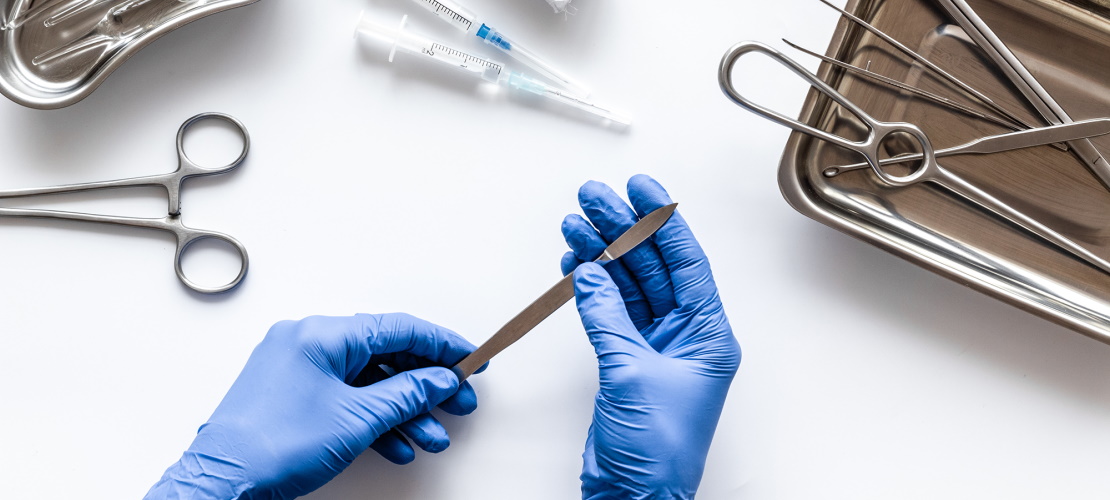The Challenge
In the future operational environment, forces will be highly mobile, operating at reach from large logistic hubs. Consequently, Medical Treatment Facilities (MTFs) will need to relocate frequently and be delivered to sites by air, sea, or ground manoeuvre platforms. Currently the UK Forward Deployed Hospital Care (Fwd DHC) deploys initially with six sterile Damage Control Surgery (DCS) reusable surgical instrument sets and once opened or used, surgical instrument sets require full medical device decontamination (cleaning, disinfection, sterilization, and sterile storage) prior to being reused. To address this bottleneck, enabling the treatment of additional casualties potentially requiring damage control surgery, a need emerged to identify commercially available, high technology readiness decontamination solutions capable of generating at least 12 surgical sets over 72 hours.
Facilitating a pan-industry view
Futures Lab engaged a multidisciplinary research team to conduct a rapid market survey to deepen understanding of the potential solution space for the decontamination process of medical devices. Consisting of six SME organisations from micro to mid-scale, including change specialists, facilitators, Sterilisation and Decontamination engineering manufacturers, scientists and technologists.
Approach
The scope of the work was limited to high technology readiness level (TRL) solutions on the market suitable for Fwd Medical Device Decontamination Capability (MDDC). The current standards, methods, logistics and training requirements were out of scope and considered fixed (changing the policies and accreditations was considered to be overly time-consuming). Whilst immediate exploitation was a key criterion, insight was also sought to identify medium to longer-term solutions that warranted further investigation, and have the scope to flex the standards, so that they take account of the military setting. To identify solutions, ‘technology watch’ activities were undertaken, including desk research and engagement with potential suppliers. This was then augmented with collaborative workshops with user group representatives, suppliers, and decontamination subject matter experts (SMEs), enabling discussion and constructive challenge to solution desirability, feasibility, and viability.
Market Survey Overview
To address the immediate requirement, it was found that there are only two ruggedised steam autoclaves on the market that fit the requirement constraints, both of which were produced by a US manufacturer for US forces and have Food and Drug Administration (FDA) approval.
Engagement through Futures Lab with manufacturers, one US/UK and one UK, shows that there are technologies at TRL 7, 8 or 9 that could usefully be adapted for the military setting, exploiting ozone and HOCl (hypochlorous acid).
In the short to medium term, there are alternative techniques for sterilizing surgical sets, including ozone gas sterilization and hydrogen peroxide. Equipment for these processes is available and some examples are ruggedised. These would however need to be accredited for clinical use and suitability in the context of Fwd DHC.
For the medium term, there is a case to investigate both ozone and HOCl further. This needs to consider the whole decontamination cycle, not just sterilization but also the other disinfection requirements and the potential by-products. While obtaining clinical accreditation for either is likely to be time-consuming, there is scope in the meantime to review the applicability of NHS standards to Fwd DHC MTFs working in austere environments.
Ozone sterilization, unlike steam autoclaves, does not require water and in some cases can also be used to produce oxygen. Ozone can also be used to disinfect an enclosed space by fogging. Ozone however is hazardous above certain concentrations in the atmosphere, so some procedures would need to change. Clinical approval would also be required.
HOCl sterilization, unlike steam autoclaves, does not require supply of clean water and can be used widely as a disinfectant or cleaner in many settings, directly or through fogging. It is safe for humans and the environment and has some clinical uses, such as treating burns and perioperative care. It is not currently used for sterilizing surgical instruments in caskets or wrapped and would need clinical approval. Currently US-approved methods for sterilizing surgical instruments using HOCl would take too long to be of practical use in a Fwd MTF.
In the medium to longer term there are other solutions that could, at least in theory, be adapted for military use cases and the operational environment. At this point, most can be ruled out because either they do not have approval (e.g. from the NHS or the US FDA) or they are impractical (e.g. 3D printing), though these constraints may change.
Obtaining clinical accreditation for the use of ozone or HOCl for medical device decontamination in Fwd DHC is likely to be time-consuming given the long-standing preference for high-temperature steam.
Recommendations for Future Changes
Based on this rapid market survey it is recommended that:
- A procurement process for the current requirement for medical device sterilizers should use the evaluation criteria drafted through this analysis and be based on a trial of the two ruggedised sterilizers on the market in comparison with the current sterilizer.
- The short to medium term requirement should be explored and better defined by using an MTF set up for a training exercise to model the whole decontamination process (not just sterilization). This would support a process improvement approach to the whole decontamination cycle and could provide a realistic environment which potential suppliers could engage with and act as a spur to innovation.
- The results of the process improvement exercise should be used in a mathematical model of the decontamination cycle to support judgements about the balance of risks and the optimisation of costs and operational effectiveness.
- The Foreign, Commonwealth and Development Office should be approached to explore whether sharing the cost of trials of HOCl would be an efficient way to support the UK’s commitment to realising the Sustainable Development Goals 3 (Good Health and Wellbeing) and 6 (Clean Water and Sanitation).
Contributing Organisations include: Arke Ltd, BearingPoint, GreenTeck, J Tucker AP Services Ltd, Horstman, QinetiQ

